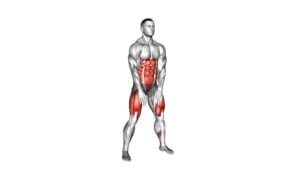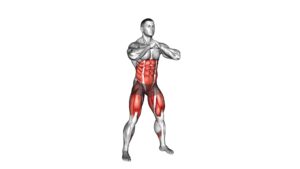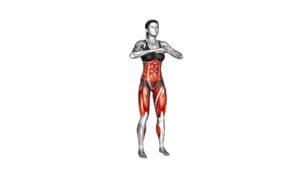High Knee Squat (VERSION 3) (female) – Video Exercise Guide & Tips

Looking to tone your legs and strengthen your core? Look no further than the high knee squat.
Watch This Exercise Video
In this video exercise guide, we'll show you the proper form and technique for this effective workout.
Whether you're a beginner or advanced, we've got modifications and variations to suit your fitness level.
Say goodbye to common mistakes and hello to results with our helpful tips.
Get ready to incorporate high knee squats into your routine and take your fitness to the next level.
Key Takeaways
- High knee squats are effective for burning calories and aiding in weight loss.
- They target core muscles, glutes, and quads simultaneously.
- High knee squats maximize calorie burn and tone multiple areas of the body.
- Engaging core muscles during high knee squats improves balance and stability.
Benefits of High Knee Squats for Women
Discover the numerous benefits you can experience as a woman by incorporating high knee squats into your exercise routine. High knee squats are a great way to burn calories and aid in weight loss. Unlike regular squats, high knee squats target your core muscles, glutes, and quads, all at the same time. This means that you can maximize your calorie burn and tone multiple areas of your body in one exercise.
One of the main benefits of high knee squats for weight loss is that they elevate your heart rate, increasing your overall calorie expenditure. By engaging multiple muscle groups, high knee squats require more energy, resulting in a higher calorie burn. Additionally, the explosive movement of lifting your knees towards your chest adds an element of cardio to the exercise, further enhancing calorie burn.
Another advantage of high knee squats for women is that they improve balance and stability. As you lift your knees up, you engage your core muscles, which are essential for maintaining balance. This can be particularly beneficial for women who may have weaker core muscles or who are looking to improve their overall stability.
Proper Form and Technique for High Knee Squats
To perform high knee squats with proper form and technique, you need to focus on engaging your core muscles and maintaining balance throughout the movement. Proper technique is crucial to maximize the benefits of this exercise and minimize the risk of injury.
One common mistake to avoid is allowing your knees to cave inwards during the squat. Instead, make sure to push your knees outwards and in line with your toes to maintain proper alignment.
Another mistake isn't going low enough in your squat, which can limit the effectiveness of the exercise. Aim to lower yourself until your thighs are parallel to the ground or even lower if you can.
It's also important to keep your back straight and chest lifted throughout the movement. Avoid rounding your back or leaning forward excessively.
By maintaining proper form and technique, you can ensure that you're targeting the correct muscles and getting the most out of your high knee squats.
Now, let's explore some modifications and variations for high knee squats.
Modifications and Variations for High Knee Squats
To modify or vary high knee squats, you can incorporate different equipment or add a plyometric element to intensify the exercise. One alternative exercise to high knee squats is the resistance band high knee squat. This variation involves wrapping a resistance band around your thighs, just above your knees, to add resistance and engage your leg muscles even more.
Another option is the dumbbell high knee squat, where you hold a dumbbell in each hand and perform the squat while lifting your knees high. This not only targets your leg muscles but also adds an upper body challenge.
If you want to add a plyometric element to your high knee squats, you can try the high knee jump squat. This involves explosively jumping off the ground while bringing your knees up towards your chest. This variation increases the intensity and cardiovascular benefits of the exercise.
Remember to start with a weight or resistance level that's appropriate for your fitness level and gradually increase as you become stronger.
Now that you know some modifications and variations for high knee squats, let's discuss common mistakes to avoid during this exercise.
Common Mistakes to Avoid During High Knee Squats
To avoid common mistakes during high knee squats, make sure to focus on maintaining proper form and engaging your core throughout the exercise.
One common mistake is letting your knees cave inward as you squat down. This puts unnecessary strain on your knees and can lead to injury. To prevent this, actively push your knees outwards as you lower into the squat position.
Another mistake to avoid is rounding your back or hunching your shoulders. This not only compromises your form but also puts strain on your spine. Keep your back straight and shoulders pulled back throughout the movement.
Additionally, be cautious not to rush the exercise or use momentum to lift your knees. This takes away from the effectiveness of the exercise and can lead to improper form. Instead, focus on controlled movements and engaging your core muscles to lift your knees towards your chest.
Tips for Incorporating High Knee Squats Into Your Fitness Routine
To incorporate high knee squats into your fitness routine, you should start by warming up your body with some light cardio exercises. This will help increase blood flow and prepare your muscles for the workout. Once you're warmed up, you can begin performing high knee squats.
High knee squats are a great exercise because they target multiple muscle groups, including the quadriceps, hamstrings, and glutes. They also help improve balance and stability. To reap the full benefits of high knee squats, it's important to maintain proper form throughout the exercise. Keep your back straight, chest up, and engage your core muscles.
If you're new to high knee squats or have any physical limitations, there are workout modifications you can try. For beginners, you can start by performing the squats at a slower pace and gradually increase your speed as you build strength and confidence. If you have knee or joint issues, you can decrease the depth of the squat or perform the exercise with the assistance of a chair or wall for added support.
Incorporating high knee squats into your fitness routine can help improve lower body strength, stability, and overall fitness. Remember to listen to your body and make any necessary modifications to ensure a safe and effective workout.
Frequently Asked Questions
Can High Knee Squats Help With Weight Loss?
High knee squats can be an effective exercise for weight loss. By incorporating high knee squat variations into your workout routine, you can increase your heart rate and burn more calories.
In addition to aiding in weight loss, high knee squats offer various benefits for overall fitness. They can help strengthen your leg muscles, improve balance and coordination, and enhance core stability.
Incorporating high knee squats into your fitness regimen can contribute to your weight loss goals while improving your overall fitness.
How Many Calories Can Be Burned During a High Knee Squat Workout?
During a high knee squat workout, you can burn a significant amount of calories.
Incorporating high knee squats into a HIIT workout routine can provide numerous benefits, including increased calorie burn, improved cardiovascular fitness, and strengthened lower body muscles.
To modify high knee squats for a low impact option, you can perform them at a slower pace or with smaller knee lifts. This allows you to still enjoy the benefits while reducing stress on your joints.
Do High Knee Squats Specifically Target the Thigh Muscles?
High knee squats are an effective exercise for targeting the thigh muscles. They help to strengthen and tone your quadriceps, hamstrings, and glutes. In addition to targeting the thighs, high knee squats also provide benefits for overall leg strength.
To make your workout more challenging, you can try variations such as adding weights, performing jump squats, or incorporating a plyometric element. These variations will help to intensify the exercise and further engage your leg muscles.
Can High Knee Squats Improve Balance and Coordination?
High knee squats can do more than just target your thigh muscles. They can also improve your balance and coordination. By incorporating high knee squats into your workout routine, you're training your body to maintain stability and control while performing dynamic movements.
This can help improve your agility and enhance your athletic performance in various sports and activities. So, don't underestimate the benefits of high knee squats beyond just working your thighs.
Keep squatting and enjoy the added benefits!
Are High Knee Squats Suitable for Beginners or Should They Be Done by More Advanced Fitness Enthusiasts?
High knee squats can be suitable for beginners as they offer modifications to accommodate different fitness levels. These squats are beneficial for beginners as they help improve balance and coordination.
By engaging multiple muscle groups, high knee squats can also enhance overall strength and endurance. Incorporating high knee squats into your fitness routine can provide a challenging yet effective workout, regardless of your fitness level.
Remember to listen to your body and adjust the intensity as needed.
Conclusion
In conclusion, high knee squats are a beneficial exercise for women that can help improve strength, flexibility, and overall fitness.
By maintaining proper form and technique and avoiding common mistakes, you can maximize the benefits of this exercise.
Additionally, there are modifications and variations available to suit different fitness levels and goals.
Incorporating high knee squats into your fitness routine can be a great way to challenge yourself and achieve your fitness goals.

Author
Years ago, the spark of my life’s passion ignited in my mind the moment I stepped into the local gym for the first time. The inaugural bead of perspiration, the initial endeavor, the very first surge of endorphins, and a sense of pride that washed over me post-workout marked the beginning of my deep-seated interest in strength sports, fitness, and sports nutrition. This very curiosity blossomed rapidly into a profound fascination, propelling me to earn a Master’s degree in Physical Education from the Academy of Physical Education in Krakow, followed by a Sports Manager diploma from the Jagiellonian University. My journey of growth led me to gain more specialized qualifications, such as being a certified personal trainer with a focus on sports dietetics, a lifeguard, and an instructor for wellness and corrective gymnastics. Theoretical knowledge paired seamlessly with practical experience, reinforcing my belief that the transformation of individuals under my guidance was also a reflection of my personal growth. This belief holds true even today. Each day, I strive to push the boundaries and explore new realms. These realms gently elevate me to greater heights. The unique combination of passion for my field and the continuous quest for growth fuels my drive to break new ground.







